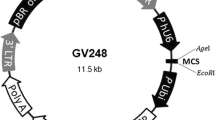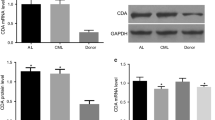Abstract
Chronic myeloid leukemia (CML) is a clonal disorder characterized by excessive accumulation of myeloid cells in the peripheral blood. In the present study, to investigate the role of Hiwi in leukemogenesis, lentivirus-mediated Hiwi overexpression was performed in a CML cell line, K562 cells. Our data revealed that Hiwi protein expression was undetectable in K562 cells, and its overexpression suppressed cell proliferation, induced cell cycle arrest at G0/G1 and G2/M phases, and promoted apoptosis in K562 cells in vitro. Expression of anti-apoptotic protein, Bcl-2, was decreased in cells expressing Hiwi, whereas that of pro-apoptotic proteins, Bax, activated caspase-3, -9, and cleaved poly (ADP-ribose) polymerase were increased. Additionally, Hiwi upregulation enhanced the chemosensitivity of CML cells to daunomycin. Our study illustrates that expression deletion of Hiwi may be involved in the pathogenesis of human CML and suggests a possible role of Hiwi in regulating the cell growth, cell cycle, and apoptosis of CML cells in vitro.





Similar content being viewed by others
References
Hamad, A., Sahli, Z., El Sabban, M., Mouteirik, M., & Nasr, R. (2013). Emerging therapeutic strategies for targeting chronic myeloid leukemia stem cells. Stem Cells International, 2013(2012), 724360.
Stapnes, C., Gjertsen, B. T., Reikvam, H., & Bruserud, O. (2009). Targeted therapy in acute myeloid leukaemia: Current status and future directions. Expert Opinion on Investigational Drugs, 18(4), 433–455.
Ito, T. (2013). Stem cell maintenance and disease progression in chronic myeloid leukemia. International Journal of Hematology, 98(6), 641–647.
Cross, N. C., Daley, G. Q., Green, A. R., Hughes, T. P., Jamieson, C., Manley, P., et al. (2008). BCR-ABL1-positive CML and BCR-ABL1-negative chronic myeloproliferative disorders: Some common and contrasting features. Leukemia, 22(11), 1975–1989.
Perrotti, D., Jamieson, C., Goldman, J., & Skorski, T. (2010). Chronic myeloid leukemia: Mechanisms of blastic transformation. The Journal of Clinical Investigation, 120(7), 2254–2264.
el-Shami, K., & Smith, B. D. (2008). Immunotherapy for myeloid leukemias: Current status and future directions. Leukemia, 22(9), 1658–1664.
Cea, M., Cagnetta, A., Nencioni, A., Gobbi, M., & Patrone, F. (2013). New insights into biology of chronic myeloid leukemia: Implications in therapy. Current Cancer Drug Targets, 13(7), 711–723.
Cox, D. N., Chao, A., Baker, J., Chang, L., Qiao, D., & Lin, H. (1998). A novel class of evolutionarily conserved genes defined by piwi are essential for stem cell self-renewal. Genes & Development, 12(23), 3715–3727.
Siomi, M. C., Sato, K., Pezic, D., & Aravin, A. A. (2011). PIWI-interacting small RNAs: The vanguard of genome defence. Nature Reviews Molecular Cell Biology, 12(4), 246–258.
Qiao, D., Zeeman, A. M., Deng, W., Looijenga, L. H., & Lin, H. (2002). Molecular characterization of hiwi, a human member of the piwi gene family whose overexpression is correlated to seminomas. Oncogene, 21(25), 3988–3999.
Taubert, H., Greither, T., Kaushal, D., Wurl, P., Bache, M., Bartel, F., et al. (2007). Expression of the stem cell self-renewal gene Hiwi and risk of tumour-related death in patients with soft-tissue sarcoma. Oncogene, 26(7), 1098–1100.
Yang, L. J., Chen, Y., Ma, Q., Fang, J., He, J., Cheng, Y. Q., & Wu, Q. L. (2010). Effect of betulinic acid on the regulation of Hiwi and cyclin B1 in human gastric adenocarcinoma AGS cells. Acta Pharmacologica Sinica, 31(1), 66–72.
Grochola, L. F., Greither, T., Taubert, H., Moller, P., Knippschild, U., Udelnow, A., et al. (2008). The stem cell-associated Hiwi gene in human adenocarcinoma of the pancreas: Expression and risk of tumour-related death. British Journal of Cancer, 99(7), 1083–1088.
Wang, D. W., Wang, Z. H., Wang, L. L., Song, Y., & Zhang, G. Z. (2014). Overexpression of hiwi promotes growth of human breast cancer cells. Asian Pacific Journal of Cancer Prevention, 15(18), 7553–7558.
Liu, W., Gao, Q., Chen, K., Xue, X., Li, M., Chen, Q., et al. (2014). Hiwi facilitates chemoresistance as a cancer stem cell marker in cervical cancer. Oncology Reports, 32(5), 1853–1860.
Wang, X., Tong, X., Gao, H., Yan, X., Xu, X., Sun, S., et al. (2014). Silencing HIWI suppresses the growth, invasion and migration of glioma cells. International Journal of Oncology, 45(6), 2385–2392.
Liang, D., Fang, Z., Dong, M., Liang, C., Xing, C., Zhao, J., & Yang, Y. (2012). Effect of RNA interference-related HiWi gene expression on the proliferation and apoptosis of lung cancer stem cells. Oncology Letters, 4(1), 146–150.
Sharma, A. K., Nelson, M. C., Brandt, J. E., Wessman, M., Mahmud, N., Weller, K. P., & Hoffman, R. (2001). Human CD34(+) stem cells express the hiwi gene, a human homologue of the Drosophila gene piwi. Blood, 97(2), 426–434.
He, R., Liu, B., Yang, C., Yang, R. C., Tobelem, G., & Han, Z. C. (2003). Inhibition of K562 leukemia angiogenesis and growth by expression of antisense vascular endothelial growth factor (VEGF) sequence. Cancer Gene Therapy, 10(12), 879–886.
Zhang, J. H., Liu, L. Q., He, Y. L., Kong, W. J., & Huang, S. A. (2010). Cytotoxic effect of trans-cinnamaldehyde on human leukemia K562 cells. Acta Pharmacologica Sinica, 31(7), 861–866.
Siddiqi, S., Terry, M., & Matushansky, I. (2012). Hiwi mediated tumorigenesis is associated with DNA hypermethylation. PLoS ONE, 7(3), e33711.
Liang, D., Dong, M., Hu, L. J., Fang, Z. H., Xu, X., Shi, E. H., & Yang, Y. J. (2013). Hiwi knockdown inhibits the growth of lung cancer in nude mice. Asian Pacific Journal of Cancer Prevention, 14(2), 1067–1072.
Wu, Q., Ma, Q., Shehadeh, L. A., Wilson, A., Xia, L., Yu, H., & Webster, K. A. (2010). Expression of the Argonaute protein PiwiL2 and piRNAs in adult mouse mesenchymal stem cells. Biochemical and Biophysical Research Communications, 396(4), 915–920.
Kitada, S., Pedersen, I. M., Schimmer, A. D., & Re, J. C. (2002). Dysregulation of apoptosis genes in hematopoietic malignancies. Oncogene, 21(21), 3459–3474.
Wong, R. S. (2011). Apoptosis in cancer: From pathogenesis to treatment. Journal of Experimental and Clinical Cancer Research, 30(1), 87.
Schmitt, E., Steyaert, A., Cimoli, G., & Bertrand, R. (1998). Bax-alpha promotes apoptosis induced by cancer chemotherapy and accelerates the activation of caspase 3-like cysteine proteases in p53 double mutant B lymphoma Namalwa cells. Cell Death and Differentiation, 5(6), 506–516.
Li, Z., Zhao, J., Li, Q., Yang, W., Song, Q., Li, W., & Liu, J. (2010). KLF4 promotes hydrogen-peroxide-induced apoptosis of chronic myeloid leukemia cells involving the bcl-2/bax pathway. Cell Stress and Chaperones, 15(6), 905–912.
Rao, J., Xu, D. R., Zheng, F. M., Long, Z. J., Huang, S. S., Wu, X., et al. (2011). Curcumin reduces expression of Bcl-2, leading to apoptosis in daunorubicin-insensitive CD34+ acute myeloid leukemia cell lines and primary sorted CD34+ acute myeloid leukemia cells. Journal of Translational Medicine, 9(1), 71.
Kaufmann, S. H., & Earnshaw, W. C. (2000). Induction of apoptosis by cancer chemotherapy. Experimental Cell Research, 256(1), 42–49.
Hess, F., Estrugo, D., Fischer, A., Belka, C., & Cordes, N. (2007). Integrin-linked kinase interacts with caspase-9 and -8 in an adhesion-dependent manner for promoting radiation-induced apoptosis in human leukemia cells. Oncogene, 26, 1372–1384.
Wunderlich, M., Mizukawa, B., Chou, F. S., Sexton, C., Shrestha, M., Saunthararajah, Y., & Mulloy, J. C. (2013). AML cells are differentially sensitive to chemotherapy treatment in a human xenograft model. Blood, 121(12), e90–e97.
Bhamidipati, P. K., Kantarjian, H., Cortes, J., Cornelison, A. M., & Jabbour, E. (2013). Management of imatinib-resistant patients with chronic myeloid leukemia. Therapeutic Advances in Hematology, 4(2), 103–117.
Rumjanek, V. M., Vidal, R. S., & Maia, R. C. (2013). Multidrug resistance in chronic myeloid leukaemia: How much can we learn from MDR-CML cell lines? Bioscience Reports, 33, 875–888.
Acknowledgments
This study was supported by a Grant from the Foundation of Department of Science and Technology, Jilin Province (No.: 200705181).
Author information
Authors and Affiliations
Corresponding author
Additional information
Yalin Wang and Yan Jiang have contributed equally to this study.
Rights and permissions
About this article
Cite this article
Wang, Y., Jiang, Y., Bian, C. et al. Overexpression of Hiwi Inhibits the Cell Growth of Chronic Myeloid Leukemia K562 Cells and Enhances Their Chemosensitivity to Daunomycin. Cell Biochem Biophys 73, 129–135 (2015). https://doi.org/10.1007/s12013-015-0668-7
Published:
Issue Date:
DOI: https://doi.org/10.1007/s12013-015-0668-7




